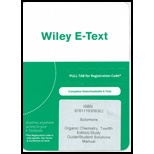
Interpretation:
The given solvent capable of dissolving ionic compounds is to be identified.
Concept Introduction:
▸ A general rule of solubility is: like dissolves like.
▸ Polar and ionic solids are dissolved in polar solvents.
▸ Nonpolar solids are dissolved in nonpolar solvents.
▸ If a molecule has dipole moment, it is termed as polar molecule. The symmetrical molecules are non-polar because the dipole moment cancel each other.
▸ The species resistant to water or the species that are incompatible with water are termed as hydrophobic.
▸ The water loving species or the species compatible with water are termed as hydrophilic species.
▸ If the compound contains one hydrophilic group and more than six carbon atoms, then the compound is insoluble in water.
▸ Alkyl chains with high molecular weight are hydrophobic in nature.
▸ The hydroxyl group is hydrophilic in nature because it forms hydrogen bonding with water molecules.
▸ The carbonyl oxygen and hydroxyl group of
▸ A hydrogen bond is a partially electrostatic force of attraction between a hydrogen atom which is bound to more electronegative atom such as nitrogen, oxygen or fluorine and another atom bearing a lone pair of electron.
▸ The liquid
▸ The liquid
▸ In benzene, the bonds are polar due to the presence of electronegativity difference between carbon and hydrogen but the dipole moment cancel out due to the symmetrical structure of benzene. The net dipole moment is zero which makes the molecule non-polar.
Want to see the full answer?
Check out a sample textbook solution
Chapter 2 Solutions
ORGANIC CHEMISTRY-ETEXT REG ACCESS
- no AI walkthrough current image is wrong answerarrow_forwarda. Determine whether each of the Followery Molecules is in the R- On the y- Configuration 1-01"/ 1-6-4 Br 4 I el Br b. Draw The Fisher projection For all the Meso compounds that can exist FOR The Following molenlearrow_forward1- Refer to the monosaccharides below to answer each of the following question(s): CH₂OH CHO CH₂OH CH₂OH 0 H- OH 0 0 HO- H H- -OH HO H HO H H OH HO- H CH₂OH H. OH HO H HO- H CH₂OH CH₂OH CH3 a. Sorbose b. Rhamnose c. Erythrulose d. Xylulose Classify each sugar by type; for example, glucose is an aldohexose. a. Xylulose is .. b. Erythrulose is . c. Sorbose is .. d. Rhamnose is .. 2- Consider the reaction below to answer the following question(s). CHO H OH CH₂OH CH₂OH HO- H HO HO + H. -OH HO OH HO. H OH OH H -OH H OH CH₂OH Q Z a. Refer to Exhibit 25-11. Place a triangle around the anomeric carbon in compound Q. Compound Z is: b. 1. the D-anomer. 2. the a-anomer. 3. the ẞ-anomer. 4. the L-anomer. c. Which anomer is the LEAST stable? d. Q and Z are cyclic examples of: a. acetals b. hemiacetals c. alditols d. hemialditolsarrow_forward
- i need help identifying the four carbon oxygen bonds in the following:arrow_forwardImagine each of the molecules shown below was found in an aqueous solution. Can you tell whether the solution is acidic, basic, or neutral? molecule HO H3N + The solution is... X O acidic OH O basic H3N-CH-C-O O neutral ○ (unknown) O acidic ○ basic CH2 CH 3-S-CH2 O neutral ○ (unknown) H3N O OH O acidic O basic Oneutral O (unknown) 0 H3N-CH-C-O CH3 CH CH3 O acidic O basic O neutral ○ (unknown) ? olo Ar BHarrow_forwardno Ai walkthroughs need other product (product in picture is wrong dont submit the same thing)arrow_forward
- I have a 2 mil plastic film that degrades after 22 days at 88C and at 61C takes 153 days. What is the failure at 47C in days.arrow_forwardIf a 5 film plastic film degraded in 30 days at 35C and the same film degraded in 10 days at 55 C and 2 days at 65C what would the predicted life time be at 22C for the same film?arrow_forwardno Ai walkthroughsarrow_forward
 Chemistry: The Molecular ScienceChemistryISBN:9781285199047Author:John W. Moore, Conrad L. StanitskiPublisher:Cengage Learning
Chemistry: The Molecular ScienceChemistryISBN:9781285199047Author:John W. Moore, Conrad L. StanitskiPublisher:Cengage Learning
